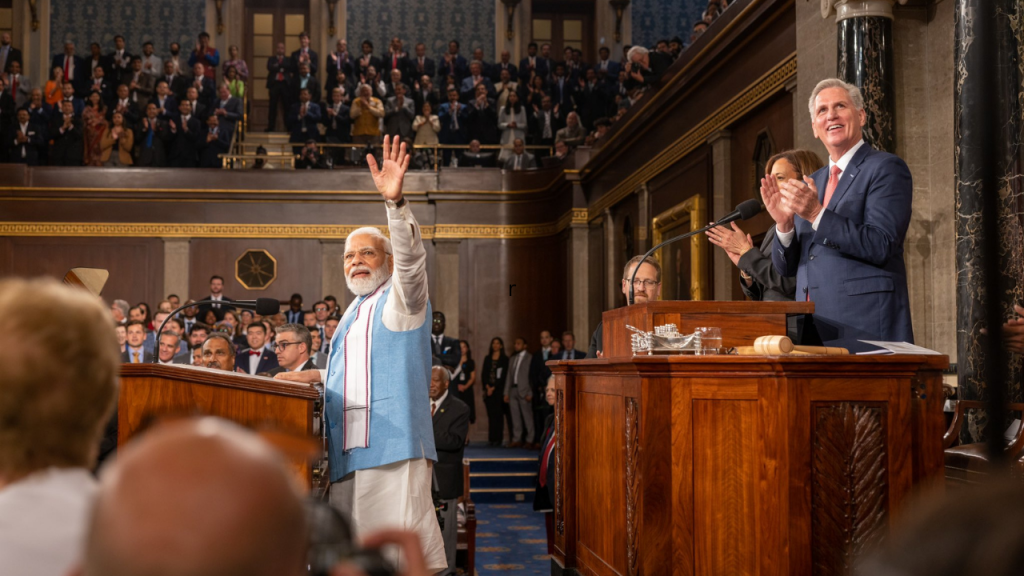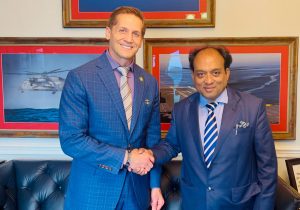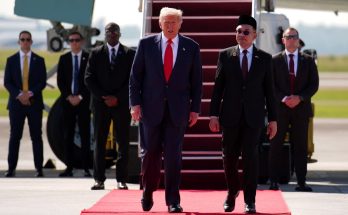
WASHINGTON: Prime Minister Narendra Modi’s recent visit to the US elevated the India-US strategic partnership to new heights and culminated in the forging of a transformational technology-driven partnership. In this freewheeling interview with Manish Chand in Washington DC, US Representative Rich McCormick highlights the importance of building stronger India-US relations for the benefit of the two countries and to counter China’s aggressive actions. McCormick, a member of the Republican Party who represents Georgia’s 6th congressional district in the US House of Representatives, also speaks about a bipartisan resolution that seeks to protect India’s sovereignty in Arunachal Pradesh.
Excerpts from the interview:
Q) The establishment of a technology-powered partnership wasd one of key outcomes of Prime Minister Modi’s historic visit to US. Will technology shape the future of India-US relations?

A) It certainly will! Consider the significant number of IT professionals who come from India to America. When you examine the visa system, one of the ongoing legislative efforts is to streamline the immigration process for individuals coming from India. Currently, we are limited to a 7% cap per year, which is absurd. There are countless qualified individuals from India who deserve work visas but are unable to obtain citizenship due to these arbitrary country-based limits. I believe these limits should be eliminated. I am proposing new legislation that has bipartisan support to simplify the citizenship process for Indian immigrants, as we need to foster their technical expertise. Moreover, there is a growing trend of individuals who acquire their education in the United States and then return to India, reinvesting in the Indian community. This contributes to the development of not just economic ties but also technological ties, ultimately fostering a synergistic relationship that benefits both nations in the future.
Certainly, we have several critical issues that have a significant impact on the large Indian community in my district, and I closely monitor these matters. It’s worth noting that one out of every five doctors in my community is originally from India. Furthermore, their children are excelling in schools, but they face discrimination when it comes to advanced education opportunities. Therefore, we are actively fighting against this discrimination. For instance, if we consider California, there is HR 403, a legislation that discriminates against Indians.
There are individuals who claim that there should be a limit on the number of Indians in college, and others who attempt to impose excessive taxes and regulations on the Indian community. I firmly believe that the Indian community, including the diaspora who have come here and are integrating into American society, achieving remarkable success, should be cautious about their political affiliations and where they lend their support.
There is a clear distinction between political parties when it comes to rewarding hard work, ingenuity, creativity and productivity, versus punishing it in the pursuit of equity. Those who immigrate from India do not seek equity; they strive for success, both for themselves and their children. That’s precisely why they surpass others in schools, excel in business acumen, gain admission to medical and business schools, and demonstrate exceptional success in the business world. They outperform others, not because they seek equity, but because they desire equal opportunities and equality.
Q) In his speech to the US Congress, PM Modi indirectly critiqued China and the Belt and Road Initiative (BRI). China was an important topic of discussion between PM Modi and US President Joe Biden. How do you look at the US’ relations with China, compared to the US’ relations with India?

A) Over the next 10 to 20 years, India will witness a rise in its GDP from around two and a half trillion dollars to become the world’s third-largest economy. Unlike countries such as China, who have achieved their economic growth through questionable means, I think India is taking the right path. They are achieving it through hard work and building strong relationships.
They are not pressuring or acting imperialistic like China. Therefore, it is crucial that we nurture the relationship between the US and India, as India serves as our most strategically important ally in that region. With a population of 1.47 billion, they contribute hard work, creativity, jobs, and immigration – all essential elements needed to strengthen this relationship for the future.
Talking of the China-US competition, China’s debt amounts to $52 trillion, while its GDP stands at $18 trillion. This means they have $5 trillion less than the United States but twice the debt, which can be seen as a form of cheating. Consequently, they have acquired influence in countries in the western hemisphere such as Chile, Argentina, Venezuela, Cuba, and Panama. Moreover, their manipulative practices extend to Africa and their strategic manoeuvres in the eastern Pacific Rim near India. This unfair competition allows them to undercut India’s production by exploiting slave labour and engaging in underselling. Countries like India, which require items like PPE, medications, and other goods, could compete fairly with China if the market were not manipulated.
Q) What about India-US partnership in critical technologies, compared to China?
A) Currently, we have a strained relationship with China. When we observe what China is doing, they are stealing our technologies and ideas, engaging in cheating through the use of slave labour, and manipulating the market.
In contrast, India has a friendly relationship with us. They seek to foster synergy between our two countries, ensuring that we collaborate rather than just compete with each other. This collaboration aims to create a better environment in both countries. This is especially relevant in the realm of technology because, if we look at the people who benefit in both countries, it largely stems from the IT and technology sectors. As we venture into the quantum spectrum of chips, delve deeper into AI, and envision building the future, it is crucial that we establish guardrails to ensure mutual benefits for both countries.
Q) So, this deepening partnership between India and the US will serve as a counterweight to an assertive China. What’s your take?
A) Yes, I agree that we require strong partners. No one in the region will be as powerful as India, with its population of 1.47 billion, making it the most populous democratic country. Their worldview aligns closely with ours. We need that strength and economic prowess that India is building. That sentiment resonates not only there but also with the close ties we have with immigration and the diaspora. In America, we also share a similar connection back to India, as well as with our fellow Americans.
We embody the American spirit and strive for the American dream. Having that connection is crucial as we move forward, fostering a friendly relationship that generates remarkable energy. This stands in stark contrast to systems where the government controls everything, manipulates its people, and restricts their freedoms. That’s not what we stand for. Our countries share a similar worldview and a commitment to providing opportunities to people.
Q) How can the United States and India cooperate to counter Chinese plans in South China Sea?
A) I’ve been to the South China Sea several times as a Marine. We bring Marine Expeditionary Units to their own carriers, and I can tell you that the trade link we use is crucial for the entire world. There’s a tremendous amount of shipping that goes through that area, and China should not be able to own it. They have never historically owned it. It’s not something you can simply claim and say it’s mine, which is what China is doing.
And it worries me that they are openly being aggressive towards Taiwan, which produces 100% of the AI chips. That would disrupt the world market in significant ways because, firstly, if they invade Taiwan, they would not only control the production line but would also face severe trade sanctions. Consequently, a country with whom we wouldn’t trade would own all AI production, posing an extremely dangerous situation for the entire world. The thought of the most cutting-edge and transformative technology in the world being produced in one place, which China is openly posturing to take over, is concerning.
India and the US need to come closer together militarily—to demonstrate strength and prevent such events from occurring. If we show our collective strength as allies, not just partners, by conducting joint military exercises and having India procure from the United States instead of Russia, it will signify our close relationship. That’s one of the reasons why I’m going to India; I’ll be leading a bipartisan Congressional delegation to India in mid-August to discuss such matters.

(Manish Chand is CEO, Centre for Global Insights India, a think tank focused on global affairs and India Writes Network. He is Editor-in-Chief, India and the World, a journal on international affairs)
Author Profile

- Manish Chand is Founder and Editor-in-Chief of India Writes Network (www.indiawrites.org) and India and World, a pioneering magazine focused on international affairs. He is CEO, Centre for Global India Insights, an India-based think tank focused on global affairs.
Latest entries
 India and the WorldOctober 27, 2025Modi hails the century of India and ASEAN, backs ASEAN centrality
India and the WorldOctober 27, 2025Modi hails the century of India and ASEAN, backs ASEAN centrality India and the WorldOctober 26, 2025Act East: Five reasons why ASEAN summit in Malaysia matters
India and the WorldOctober 26, 2025Act East: Five reasons why ASEAN summit in Malaysia matters India and the WorldOctober 25, 2025Malaysia Summit: India can play a bigger role in ASEAN: Anil Wadhwa
India and the WorldOctober 25, 2025Malaysia Summit: India can play a bigger role in ASEAN: Anil Wadhwa India and the WorldOctober 2, 2025With US frowning, India to host Putin in December
India and the WorldOctober 2, 2025With US frowning, India to host Putin in December







